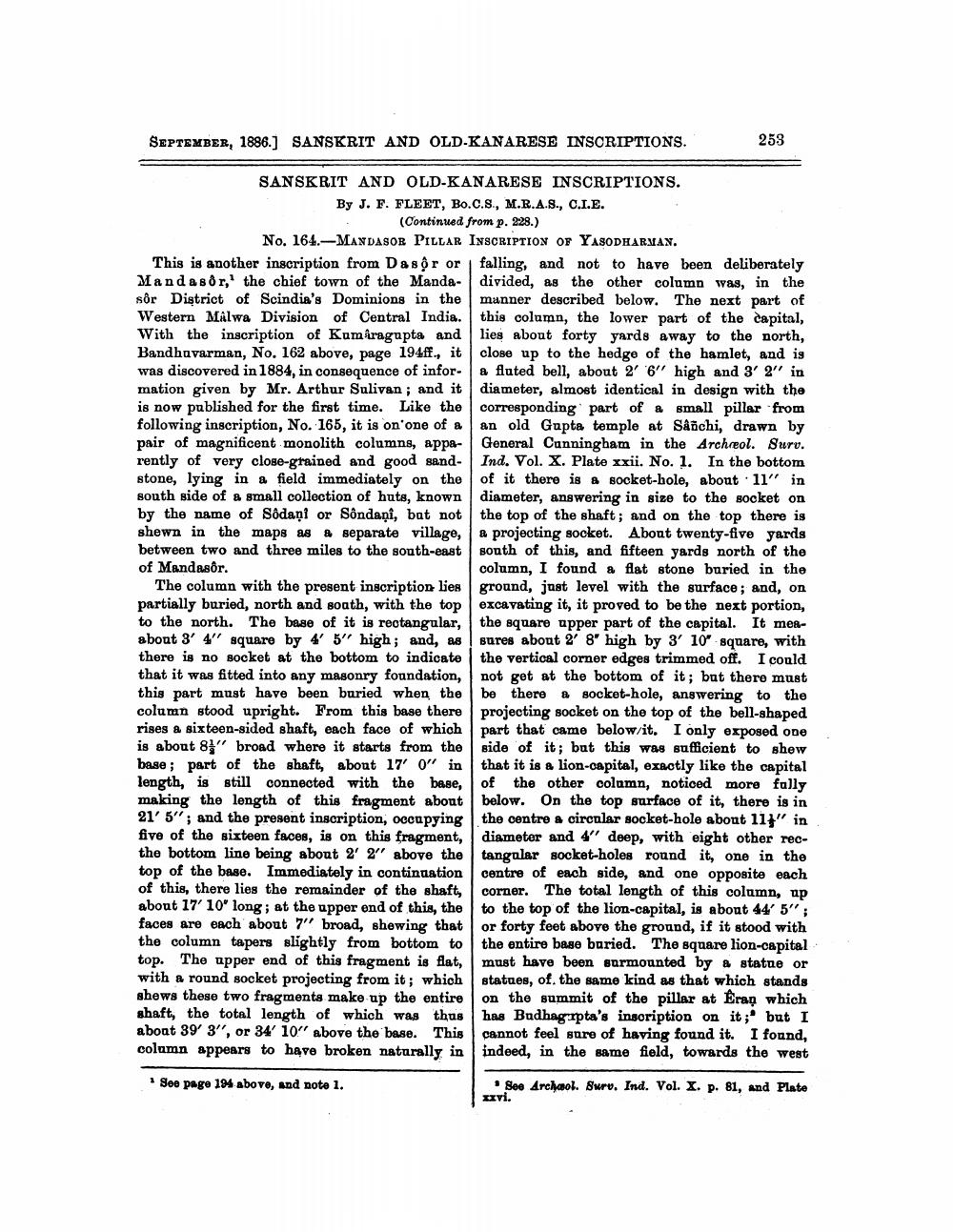________________
SEPTEMBER, 1886.] SANSKRIT AND OLD-KANARESE INSCRIPTIONS.
SANSKRIT AND OLD-KANARESE INSCRIPTIONS. By J. F. FLEET, Bo.C.S., M.R.A.S., C.I.E. (Continued from p. 228.)
No. 164.-MANDASOR PILLAR INSCRIPTION OF YASODHARMAN.
This is another inscription from Dasôr or Mandasôr, the chief town of the Mandasôr District of Scindia's Dominions in the Western Malwa Division of Central India. With the inscription of Kumaragupta and Bandhavarman, No. 162 above, page 194ff., it was discovered in 1884, in consequence of information given by Mr. Arthur Sulivan; and it is now published for the first time. Like the following inscription, No. 165, it is on one of a pair of magnificent monolith columns, apparently of very close-grained and good sandstone, lying in a field immediately on the south side of a small collection of huts, known by the name of Sôdani or Sôndanî, but not shewn in the maps as a separate village, between two and three miles to the south-east of Mandasôr.
The column with the present inscription lies partially buried, north and south, with the top to the north. The base of it is rectangular, about 3' 4" square by 4' 5" high; and, as there is no socket at the bottom to indicate that it was fitted into any masonry foundation, this part must have been buried when the column stood upright. From this base there rises a sixteen-sided shaft, each face of which is about 8" broad where it starts from the base; part of the shaft, about 17' 0" in length, is still connected with the base, making the length of this fragment about 21' 5"; and the present inscription, occupying five of the sixteen faces, is on this fragment, the bottom line being about 2' 2" above the top of the base. Immediately in continuation of this, there lies the remainder of the shaft, about 17' 10" long; at the upper end of this, the faces are each about 7" broad, shewing that the column tapers slightly from bottom to top. The upper end of this fragment is flat, with a round socket projecting from it; which shews these two fragments make up the entire shaft, the total length of which was thus about 39' 3", or 34' 10" above the base. This column appears to have broken naturally in
See page 194 above, and note 1.
253
falling, and not to have been deliberately divided, as the other column was, in the manner described below. The next part of this column, the lower part of the capital, lies about forty yards away to the north, close up to the hedge of the hamlet, and is a fluted bell, about 2' 6" high and 3' 2" in diameter, almost identical in design with the corresponding part of a small pillar from an old Gupta temple at Sâñchi, drawn by General Cunningham in the Archaeol. Surv. Ind. Vol. X. Plate xxii. No. 1. In the bottom of it there is a socket-hole, about 11" in diameter, answering in size to the socket on the top of the shaft; and on the top there is a projecting socket. About twenty-five yards south of this, and fifteen yards north of the column, I found a flat stone buried in the ground, just level with the surface; and, on excavating it, it proved to be the next portion, the square upper part of the capital. It measures about 2' 8" high by 3' 10" square, with the vertical corner edges trimmed off. I could not get at the bottom of it; but there must be there a socket-hole, answering to the projecting socket on the top of the bell-shaped part that came below it. I only exposed one side of it; but this was sufficient to shew that it is a lion-capital, exactly like the capital of the other column, noticed more fully below. On the top surface of it, there is in the centre a circular socket-hole about 11" in diameter and 4" deep, with eight other rectangular socket-holes round it, one in the centre of each side, and one opposite each corner. The total length of this column, up to the top of the lion-capital, is about 44' 5"; or forty feet above the ground, if it stood with the entire base buried. The square lion-capital must have been surmounted by a statue or statues, of. the same kind as that which stands on the summit of the pillar at Erap which has Budhagrpta's inscription on it; but I cannot feel sure of having found it. I found, indeed, in the same field, towards the west
See Archaol. Surv. Ind. Vol. X. p. 81, and Plate
xxvi.




